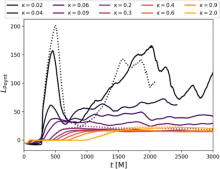
Abstract
Comparable-mass black-hole mergers generically result in moderate to highly spinning holes, whose spacetime curvature will significantly affect nearby matter in observable ways. We investigate how the moderate spin of a postmerger Kerr black hole immersed in a plasma with initially uniform density and uniform magnetic field affects potentially observable accretion rates and energy fluxes. Varying the initial specific internal energy of the plasma over two decades, we find very little change in steady-state mass accretion rate or Poynting luminosity, except at the lowest internal energies, where fluxes do not exhibit steady-state behavior during the simulation timescale. Fixing the internal energy and varying the initial fixed magnetic-field amplitude and orientation, we find that the steady-state Poynting luminosity depends strongly on the initial field angle with respect to the black hole spin axis, while the matter accretion rate is more stable until the field angle exceeds ∼45°. The protojet formed along the black hole spin axis conforms to a thin, elongated cylinder near the hole, while aligning with the asymptotic magnetic field at large distances.